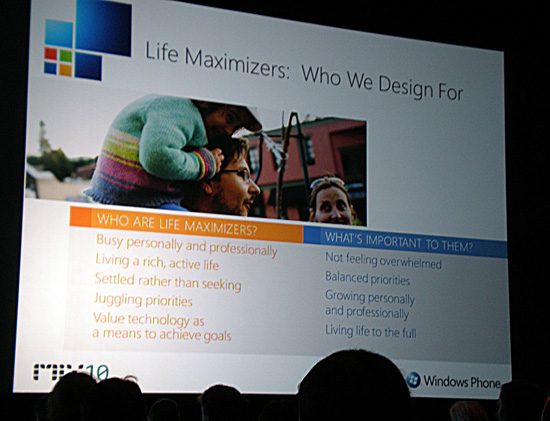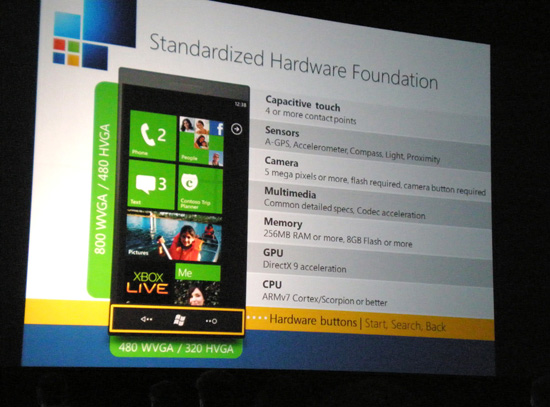Windows Phone 7 Series at MIX10
by Brian Klug on March 16, 2010 12:00 AM EST- Posted in
- Smartphones
- Mobile
Different Target Audience
I asked some of the XNA development team what they thought the biggest takeaway from the entire Phone 7 Series reboot should be, and the response was nearly unanimous: It represents a completely different target demographic focus; consumers.
Microsoft is learning from its experience with Windows Mobile by designing the phone entirely for end users and ordinary consumers; not strictly businesspeople. This target persona has been nicknamed a "Life Maximizer," and it represents the end-user the entire design, from UI to hardware, is being designed around.

Joe Belifore, VP of Phone Development, was forthcoming about both the demographic being targeted in previous Windows Mobile releases, and the tensions inherent in the development cycle for previous Windows Mobile devices. Previously, mobile operators would approach OEMs with a rough list of specifications for hardware they perceived would fill a need a gap in their lineup. The OEMs and mobile operators would work together with an existing reference design, fleshing out a device with potentially different dialers, interfaces, and end user experiences. It's a fair argument that much of the experience fragmentation that this resulted in ultimately was both Windows Mobile's biggest strength, and biggest weakness.
As we noted earlier, Phone 7 Series intends to change all of that by mandating a consistent message to end users. Part of that is also manifested in the hardware mandated now, which Microsoft has released additional details about:

Standardized Hardware Set
The specification list we heard about earlier has been fleshed out with some additional details which I've added emphasis to.
Hardware requirements are:
- Capacitive Touch
- 4 or more contact points
- Sensors
- A-GPS, Accelerometer, Compass, Light, Proximity
- Camera
- 5 megapixels or more, flash required, camera button required
- Multimedia
- Common detailed specs, Codec Acceleration
- Memory
- 256 MB RAM or more, 8 GB Flash or more
- GPU
- DirectX 9 acceleration
- CPU
- ARMv7 Cortex/Scorpion or better
- Screen
- Two Supported Displays
- 480 x 800 WVGA : Aspect Ratio 3:5
- 320 x 480 HVGA : Aspect Ratio 2:3
Note that Microsoft is now officially supporting two display resolutions; WVGA and HVGA. These are slightly different aspect ratios, with 320 x 480 HVGA being the standard 3:2 aspect ratio, and 480 x 800 being 5:3 aspect ratio. At the very least, this is something developers can be proactive about and have in mind when building software, as opposed to having the design change after the fact. Hardware launching holiday 2010 will release with 480 x 800 WVGA displays; hardware with 320 x 480 screens will launch later at some unspecified date.
I made note of this to the same XNA team mentioned earlier, who noted that scaling down applications should in theory be easier than scaling up for developers. In addition, they're looking to mitigate the aspect ratio in a number of different ways.
As for the all-important SoC choice, Microsoft is still being very tight-lipped about whether they've picked Snapdragon or one of the many other ARM-licensees' hardware designs. Reps repeatedly declined to discuss what hardware is at the core of current example hardware or whether they'll even mandate a particular chipset. In all likelihood, they'll define minimum requirements and let hardware partners meet or exceed them. Time will tell whether a particular chipset emerges as part of the requirement.
An interesting additional note not part of hardware requirements specifically, but still relevant, is that sync can be performed both tethered through USB to the computer, or over WiFi. Handsets will periodically poll computers over WiFi to see if their primary sync computer is connectible, and if so, sync. Part of the plan is to sync nightly in a manner transparent to the user and transfer photos, notes, and music so that users are never more than a day behind. I had some reservations about how well secured this method is in the long run, but we'll see more as MIX10 continues. Active Sync is dead (to much applause), and the Zune software was announced as the sync platform's successor.










24 Comments
View All Comments
Guspaz - Tuesday, March 16, 2010 - link
Ultimately, XNA is still .NET, meaning that it's analogous to Java apps on Android. The performance is quite good, but it's probably not AS good as native code would be.medi01 - Tuesday, March 16, 2010 - link
JIT compilers theoretically are producing faster code than native compilers.But android's Java VM has no JIT. I wonder if MS W7 has it.
PsychoPif - Wednesday, March 17, 2010 - link
It is the .Net Compact Framework, so yes, JIT compiler.But don't quote me on that.
pjladyfox - Tuesday, March 16, 2010 - link
This is the one big thing that will make or break any phone running this OS for me. I currently have an iPhone and, while the phone is great and I do love it, I can't STAND the fact that I have to have a frigging data plan tied to the phone. You couple that with the fact that most places where I would use any "data" feature I wind up switching over to wifi, either at Starbucks or Borders, mainly due to the lackluster 3G coverage and signal in the Bay Area.You give me the ability to get a phone running this OS without having to have a data plan and I'll get one in a heartbeat. Otherwise, I'll stick with my original plan by switching over to a iPod Touch and a basic cellphone when my iPhone contract is up later this year.
CSMR - Tuesday, March 16, 2010 - link
Of course. Microsoft isn't just manufacturing one model of the phone. You will still get bundling of some phones with contracts, unfortunately not an illegal practice, but you will be able to buy unlocked phones just as you can now.However data connections are pretty useful, if you don't like contracts fair enough but I would try to find a pay as you go provider.
pjladyfox - Tuesday, March 16, 2010 - link
The problem is that even if you get an unlocked phone most providers will force you to sign up with all of the data plan baggage that goes with it. I was considering unlocking my iPhone about a year ago but I spoke to AT&T and Verizon and they both refused to let me sign my phone up without it.I even went so far as to try asking them both if there was a smartphone that you could get WITHOUT signing up for an expensive plan and both said no giving some bunk answer about "x phone needed it" which considering the ones I would choose would have wifi enabled on them I was'nt buying it. My guess is that, for whatever reason, the handset maker in cahoots with the providers setup the phones in such a way that they "phone home" every so often setting up the "need" for the data plan.
If these companies want smartphones to take off they need to either make the data plans cheaper or give us the ability to turn off the "phone home" feature so we can use the phone as a phone without an expensive data plan. -_-
kmmatney - Tuesday, March 16, 2010 - link
You can always get a basic phone plan using a cheapo phone, and then swap over the SIMS card. I'm able to swap my SIMS card between a basic nom-smart Samsung phone and my iPhone.strikeback03 - Tuesday, March 16, 2010 - link
Verizon has recently started requiring a $10 a month data plan on non-smartphones which didn't used to require a data plan, so obviously they are just looking to collect as much money as they can. I have heard that on business accounts the data plan is optional, but I do not know for sure.braveneworld - Tuesday, March 16, 2010 - link
Developers, developers, developers, except for developers that don't want to share their code with MS or use the app store!Seriously, this is one of the main reasons the enterprise uses win mobile; you can create and install your own software without getting 'approval' from big brother MS.
In addition, if you use an app that you made that provides your company a competitive advantage, why in the world would you want to share it with your competitors? Not all software developers write software to sell!
They are going to drive many customers straight into RIM's and Google's, or even Palm's arms.
zicoz - Tuesday, March 16, 2010 - link
Paul Thurott seems to have some good news for you."And this summer--I'm thinking around the time of TechEd 2010 in June--Microsoft will announce that businesses can deploy internal Windows Phone applications privately using an as-yet unnamed "common distribution system." (I'm guessing this means WSUS or System Center Configuration Manager.)"